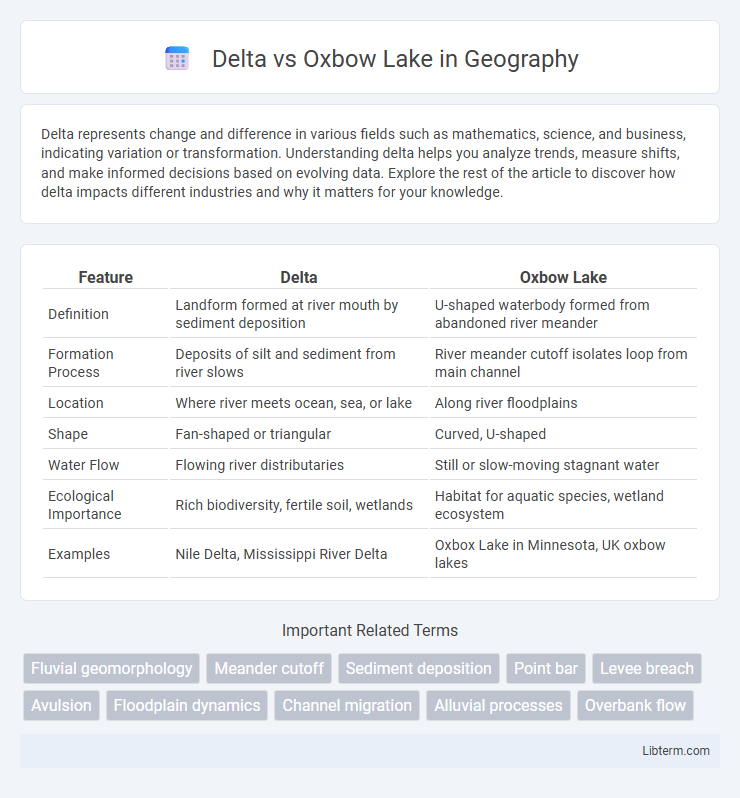Delta represents change and difference in various fields such as mathematics, science, and business, indicating variation or transformation. Understanding delta helps you analyze trends, measure shifts, and make informed decisions based on evolving data. Explore the rest of the article to discover how delta impacts different industries and why it matters for your knowledge.
Table of Comparison
| Feature | Delta | Oxbow Lake |
|---|---|---|
| Definition | Landform formed at river mouth by sediment deposition | U-shaped waterbody formed from abandoned river meander |
| Formation Process | Deposits of silt and sediment from river slows | River meander cutoff isolates loop from main channel |
| Location | Where river meets ocean, sea, or lake | Along river floodplains |
| Shape | Fan-shaped or triangular | Curved, U-shaped |
| Water Flow | Flowing river distributaries | Still or slow-moving stagnant water |
| Ecological Importance | Rich biodiversity, fertile soil, wetlands | Habitat for aquatic species, wetland ecosystem |
| Examples | Nile Delta, Mississippi River Delta | Oxbox Lake in Minnesota, UK oxbow lakes |
Introduction to Delta and Oxbow Lake
A delta forms at the mouth of a river where it deposits sediment, creating a landform that fans out into a body of water, typically an ocean or lake. An oxbow lake is a crescent-shaped water body formed when a meandering river creates a cutoff, isolating a former river bend from the main channel. Both features represent dynamic river processes but differ significantly in formation, scale, and location.
Formation Processes of Deltas
Deltas form from the deposition of sediment carried by rivers as they enter slower-moving or stagnant water bodies, such as oceans, seas, or lakes, resulting in the gradual build-up of landforms characterized by distributary channels. In contrast, oxbow lakes develop from the meandering of rivers, where a river bend is cut off due to sediment deposition and erosion, creating a crescent-shaped lake. The primary distinction lies in delta formation requiring sediment accumulation at a river mouth, while oxbow lakes result from river channel migration and cutoff processes.
How Oxbow Lakes Are Created
Oxbow lakes form when a meandering river creates a narrow neck of land that eventually erodes, causing the river to cut through and create a new, straighter channel. This process isolates the old river bend, which fills with water to become a crescent-shaped oxbow lake. Unlike deltas, which develop from sediment deposition where a river meets a larger body of water, oxbow lakes result from river meandering and channel cutoff.
Key Differences Between Delta and Oxbow Lake
A delta forms at the mouth of a river where sediments accumulate, creating a triangular landform as the river splits into multiple distributaries. An oxbow lake is a crescent-shaped water body formed from a cut-off meander of a river, isolated from the flowing channel. While deltas are depositional landforms that expand into larger bodies like oceans or lakes, oxbow lakes are isolated freshwater habitats resulting from river course changes.
Geographical Locations and Examples
A delta forms at the mouth of a river where it deposits sediment, creating rich, triangular landforms such as the Nile Delta in Egypt and the Mississippi River Delta in the United States. Oxbow lakes develop in river valleys when meanders are cut off due to sediment deposition, examples include Carter Lake on the Missouri River and Lake Chicot in Arkansas. Both features illustrate dynamic fluvial processes shaping diverse geographical landscapes across riverine environments.
Ecological Significance of Deltas
Deltas serve as highly productive ecological zones where rivers deposit nutrient-rich sediments, fostering diverse habitats that support numerous species of fish, birds, and plants. These environments act as natural water filtration systems, improving water quality and mitigating the impact of pollutants before they reach open seas. In contrast to oxbow lakes, which are isolated and smaller, deltas play a critical role in carbon sequestration and serve as buffers against storm surges and coastal erosion.
Biodiversity within Oxbow Lakes
Oxbow lakes exhibit rich biodiversity due to their unique aquatic habitats formed from abandoned river meanders, providing critical refuges for various plant and animal species. These lakes support diverse fish populations, amphibians, and bird species, contributing to regional ecological stability. In contrast to deltas, oxbow lakes offer more stable freshwater conditions that promote specialized ecosystems and higher species diversity.
Human Impact on Deltas and Oxbow Lakes
Human activities significantly alter deltas and oxbow lakes by accelerating sediment deposition and changing water flow patterns. Urban development, agriculture, and dam construction reduce sediment supply to deltas, causing land subsidence and increased erosion rates. In oxbow lakes, pollution runoff and water diversion disrupt aquatic ecosystems, leading to habitat loss and decreased biodiversity.
Economic Importance and Uses
Delta regions serve as vital economic hubs due to their fertile soils supporting agriculture, abundant fishing resources, and strategic locations for ports facilitating trade and transportation. Oxbow lakes, formed from meandering river cutoffs, contribute economically through freshwater fishing, recreational activities, and localized irrigation. Both features enhance biodiversity and provide ecosystem services crucial for sustaining livelihoods and regional economies.
Preservation and Conservation Strategies
Delta ecosystems benefit from sediment deposition that supports diverse habitats, necessitating conservation strategies such as wetland restoration, pollution control, and sustainable land use to maintain biodiversity and water quality. Oxbow lakes, formed from river meanders, require preservation efforts focused on protecting aquatic habitats, managing invasive species, and maintaining natural hydrological cycles to sustain their ecological stability. Both environments rely heavily on integrated watershed management and community engagement to enhance resilience against climate change and anthropogenic impacts.
Delta Infographic

 libterm.com
libterm.com